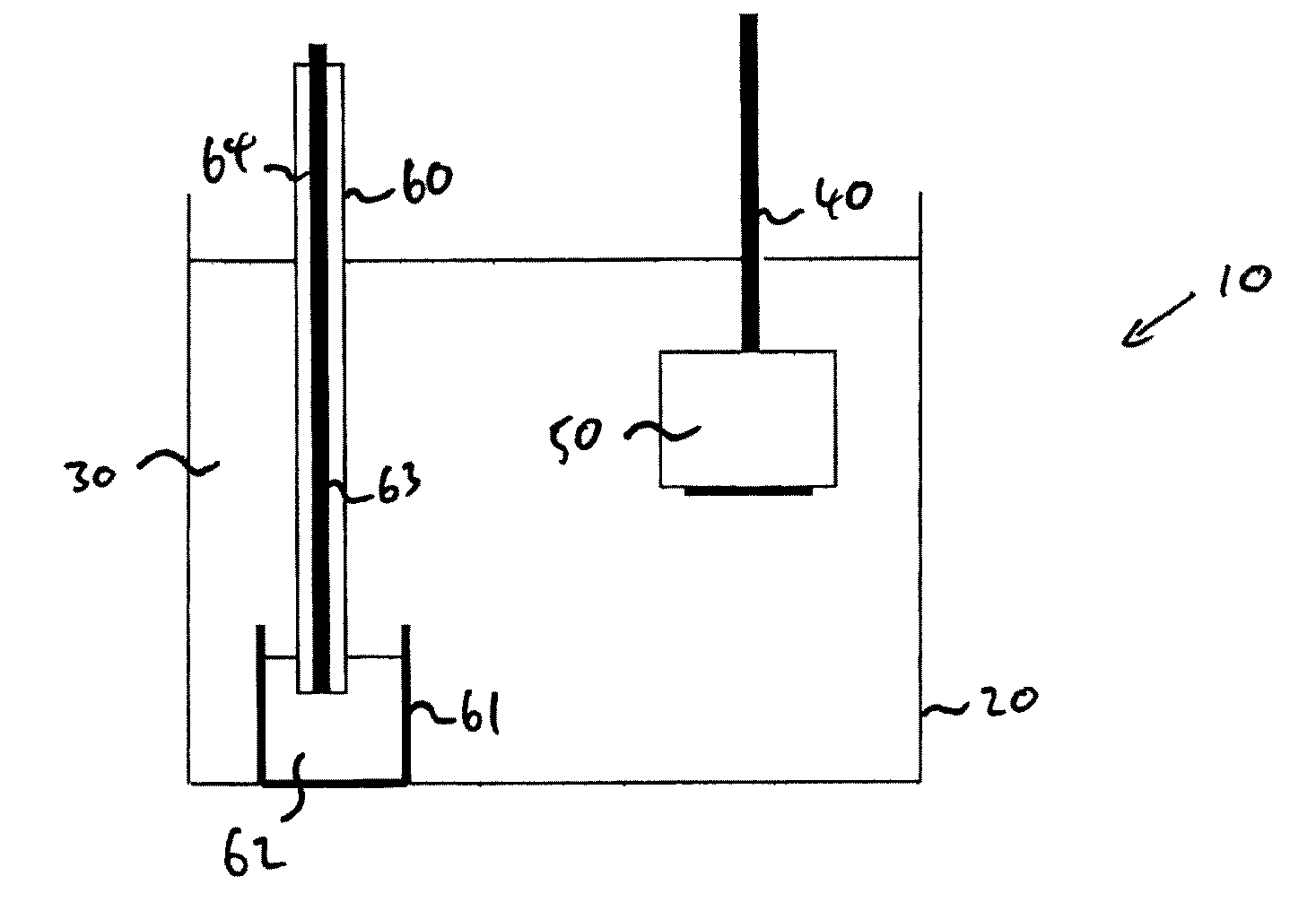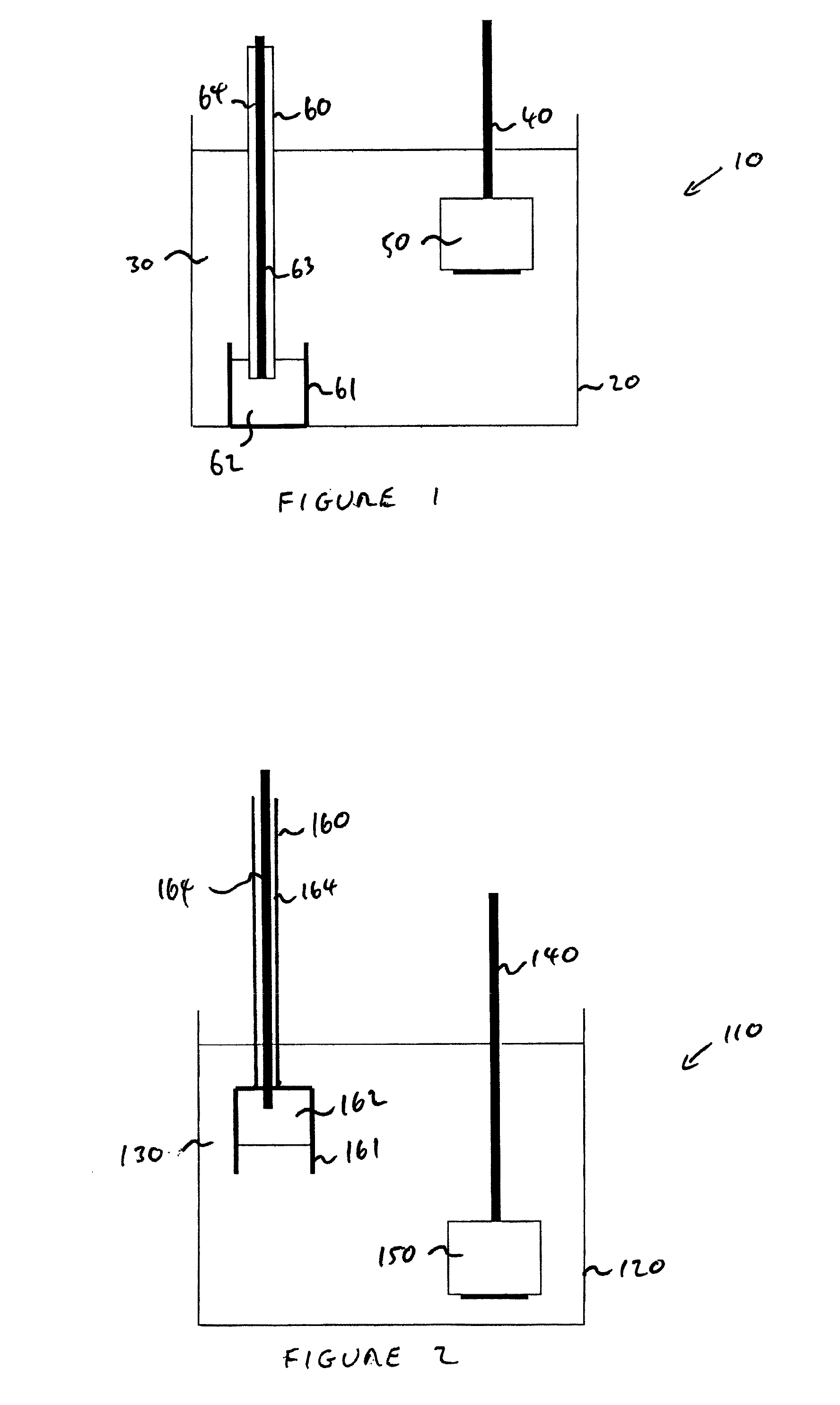Method and apparatus for producing metal by electrolytic reduction
a technology of electrolysis and reduction, applied in the direction of electrolysis components, electrolysis processes, electrolytic devices, etc., can solve the problems of reducing the efficiency of the process, tin oxide has shown some limited success, and contamination of the metal produced
- Summary
- Abstract
- Description
- Claims
- Application Information
AI Technical Summary
Benefits of technology
Problems solved by technology
Method used
Image
Examples
experiment 1
[0057]Zinc used as the anode material was AnalaR Normapur® pellets supplied by VWR International Limited. Tantalum oxide was 99.99% purity and pressed and sintered to around 45% porosity. The powder supplier was F&X electrochemicals.
[0058]An 11 gram pellet of tantalum pentoxide 50 was connected to a tantalum rod 40 and used as a cathode. 250 grams of zinc 62 was contained in an alumina crucible 61 and connected to a power supply via a tantalum connecting rod 63 sheathed in a dense alumina tube 64. This construction was used as an anode 60. One kilogram of calcium chloride 30 was used as an electrolyte and contained within a large alumina crucible 20. The anode and pellet were arranged within the molten salt 30 and the temperature of the salt was raised to approximately 800° C.
[0059]The cell was operated in constant current mode. A constant current of 2 amps was applied between the anode and cathode for a period of 8 hours. During this time the potential between the anode and the cat...
experiment 2
[0064]Lithium chloride used in this experiment was standard lithium chloride 99% purity from Leverton Clarke. In a cell configuration as illustrated in FIG. 1, a 45 g pellet 50 of tantalum pentoxide was reduced in a lithium chloride salt for a period of 25 hours at 750° C. The cell was operated at a constant current of 4 amps. The product was analysed and found to have oxygen content of 2404 ppm, carbon content of 104 ppm and a surface area of 0.3135 meters squared per gram. Less zinc dusting in the cold parts of the reactor was evident compared to the experiment performed at 800° C.
[0065]The reduced product contained some zinc contamination. This contamination could be removed by employing the heating process described in experiment 1 above.
experiment 3
[0066]A 45 g pellet of tantalum pentoxide was reduced in a lithium chloride molten salt using a molten zinc anode at a temperature of 650° C. A constant current of 4 amps was applied for a period of 30 hours and the Product contained 1619 ppm oxygen, 121 ppm carbon and a surface area of 0.6453 m2 / g. No gas evolution during electrolysis was measured by mass spectrometry. Even less zinc dusting in the cold parts of the reactor was evident compared to the experiment performed at 800° C. In contrast, tantalum oxide reduced at 650° C. in lithium chloride contained 1346 ppm carbon.
[0067]The reduced product contained some zinc contamination. This contamination could be removed by employing the heating process described in experiment 1 above.
PUM
| Property | Measurement | Unit |
|---|---|---|
| boiling point | aaaaa | aaaaa |
| melting point | aaaaa | aaaaa |
| temperature | aaaaa | aaaaa |
Abstract
Description
Claims
Application Information
 Login to View More
Login to View More - R&D
- Intellectual Property
- Life Sciences
- Materials
- Tech Scout
- Unparalleled Data Quality
- Higher Quality Content
- 60% Fewer Hallucinations
Browse by: Latest US Patents, China's latest patents, Technical Efficacy Thesaurus, Application Domain, Technology Topic, Popular Technical Reports.
© 2025 PatSnap. All rights reserved.Legal|Privacy policy|Modern Slavery Act Transparency Statement|Sitemap|About US| Contact US: help@patsnap.com


